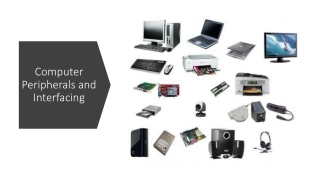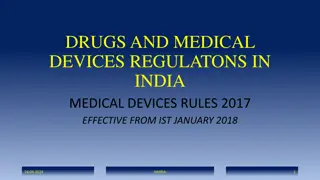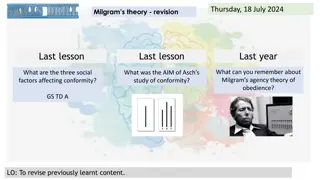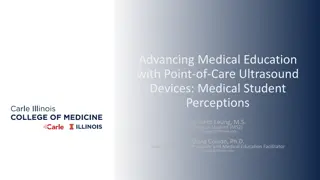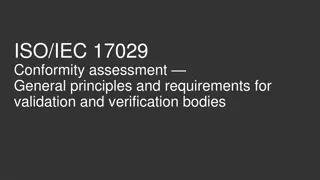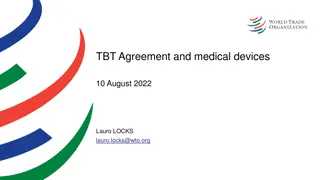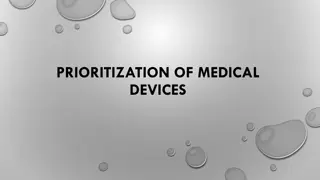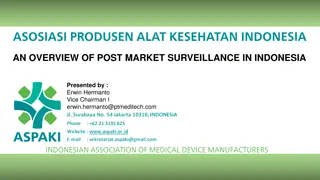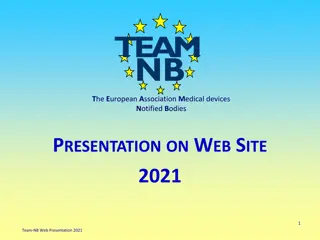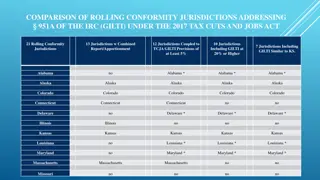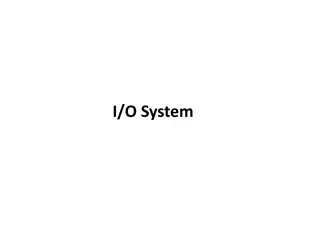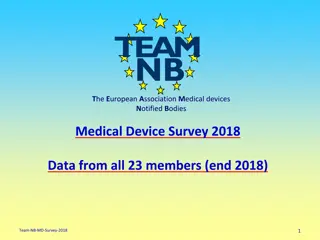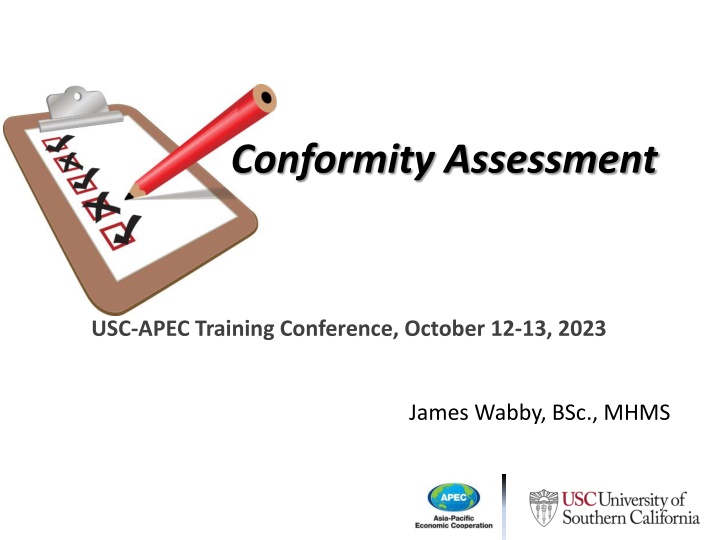
Conformity Assessment in Medical Devices Industry
Systematic examination of evidence and procedures by manufacturers to ensure medical devices are safe and meet regulatory requirements. Conformity assessment involves bodies like Notified Bodies and regulatory authorities, examining key elements such as quality management systems, post-market surveillance, and technical documentation. Various quality system regulations, such as US 21 CFR 820 and China's Regulations on the Supervision and Administration of Medical Devices, play a crucial role. ISO 13485, a key standard in the medical device industry, has a rich history dating back to its implementation in Europe in 1996, with EN ISO 13485:2016 being a widely accepted standard.
Download Presentation

Please find below an Image/Link to download the presentation.
The content on the website is provided AS IS for your information and personal use only. It may not be sold, licensed, or shared on other websites without obtaining consent from the author. If you encounter any issues during the download, it is possible that the publisher has removed the file from their server.
You are allowed to download the files provided on this website for personal or commercial use, subject to the condition that they are used lawfully. All files are the property of their respective owners.
The content on the website is provided AS IS for your information and personal use only. It may not be sold, licensed, or shared on other websites without obtaining consent from the author.
E N D
Presentation Transcript
Conformity Assessment USC-APEC Training Conference, October 12-13, 2023 James Wabby, BSc., MHMS
What is conformity assessment? The systematic examination of evidence generated, and procedures undertaken by the manufacturer, under requirements established by the Regulatory Authority, to determine that a medical device is safe and performs as intended by the manufacturer and, therefore, conforms to the Essential Principles of Safety and Performance for Medical Devices
Conformity assessment can be done by A conformity assessment body: Often called Notified Bodies A body, other than a Regulatory Authority, engaged in determining whether the relevant requirements in technical regulations or standards are fulfilled. A regulatory authority: A government body or other entity that exercises a legal right to control the use or sale of medical devices within its jurisdiction, and that may take enforcement action to ensure that medical products marketed within its jurisdiction comply with legal requirements.
Conformity Assessment looks at key elements A quality management system A system for post-market surveillance Technical documentation A declaration of conformity (implicit or explicit) Registration of manufacturers and listing of devices
Quality systems regulations may differ but have the same structure In the US, 21 CFR 820 is the legal basis China has Regulations on the Supervision and Administration of Medical Device Many other countries use certification to ISO 13485:2016 EN ISO 13485:2016+A11:2021 - Amendment Quality management System requirements in Annex IX on conformity assessment based on a quality management system and on assessment of technical documentation under EU MDR/EU IVDR ISO 13485:2016 5 of 9
History of ISO 13485 Based on the broader ISO 9001 standard ISO 13485 was first implemented in Europe in 1996 In Europe, ISO 13485 Standard designated as EN ISO 13485:2016 is seen as the de facto standard for the medical device industry
History of Quality Management Systems Why the Change? Align with current regulatory expectations Align with regulatory expectations (e.g., EU Medical Device Regulation and IVD Regulation) More applicable to the entire supply chain (e.g., manufacturers, distributors, material suppliers) Global Alignment (e.g., MDSAP or Medical Device Single Audit Program)
What is ISO 13485:2016 Section ISO 13485:2003 ISO 13485:2016 Facilitate harmonization (e.g., between IVD Directive, AIMD, MDD) Facilitate global alignment Objectives Appears 9 times Appears 37 times Regulatory Requirement Organizations provide Medical devices and related services Organizations can be involved of the life-cycle including the design and development, production, storage, and distribution, installation or servicing of a medical device and the design and development or provision of associated activities (e.g. technical support). This International Standard can also be used by suppliers or external service parties that provide product including QMS related services to such organizations. Scope & Role
Changes from ISO 13485:2003 to ISO 13485:2016 ISO 13485:2016: Terms and Definitions Section 3.0 Advisory Notice Medical Device Authorized Representative Medical Device Family Clinical Evaluation Performance Evaluation Complaint Post-Market Surveillance Distributor Product Implantable Medical Device Purchased Product Importer Risk Sterile Barrier System Risk Management Labelling Life Cycle Manufacturer Sterile Medical Device Note: Bold = Not New
History of Quality Management Systems Global Regulatory Requirements Medical Device Manufacturers need to comply with the QMS requirements of ISO 13485, with potential additional country specific quality system/regulatory requirements for use of their medical devices outside the US. Medical Device manufacturers are required to comply with FDA 21 CFR Part 820 and associated applicable FDA regulations for their devices use in the US. ISO 13485 is like 21 CFR 820, but not the same ISO 13485 audits are performed by Notified Bodies and/or Registrars, but not FDA Investigators
Under The principles of conformity assessment 4 Risk Classes of Medical Devices: A, B, C, D
Type examinations For products that are in existence at the time of establishment of a QMS, evidence of design control and the resulting outputs would be difficult for the manufacturer to demonstrate retrospectively. In these circumstances, the manufacturer may request a CAB, in jurisdictions where such is permitted, to conduct a type examination to verify conformity with the relevant Essential Principles and to establish a baseline for entry into the design and development cycle. It is expected that for future design changes to this product, originally assessed for conformity by type examination, or for the introduction of a new product, the manufacturer would introduce the full design and development controls of the QMS.
DOES THE CUSTOMER WANT? CUSTOMER REQUIREMENTS: WHAT Determine need Define customer requirements in clear, objective terms
What does the customer want? PRODUCT MEETS SPECIFIED REQUIREMENTS DEMONSTRATING COMPLIANCE WITH NEED PRODUCT PERFORMS SAFELY AND RELIABLY EVALUATING PEFORMANCE WITH SPECIFICATIONS PRODUCT IS EASY TO USE SATISFYING THE ERGONOMIC NEEDS OF THE CUSTOMERS PRODUCT WORKS ACCORDING TO INSTRUCTIONS ASSURING THAT THE PRODUCT INSTRUCTIONS ARE UNDERSTANDABLE TO THE USER
The Basis of the Process Model Product Realization Customer Requirements Customer Satisfaction
RESOURCE MANAGEMENT = Having the tools to do the job
Resources box Organization Resources Management Review Training Equipment Purchase Process Validation Manufacturing
RESOURCE MANAGEMENT ORGANIZATION - Finding the right people RESOURCES - Providing adequate capital MANAGEMENT REVIEW - Being visible - Tracking required actions TRAINING - Ensuring competence EQUIPMENT PURCHASE - Obtaining equipment to do the job PROCESS VALIDATION - Demonstrating product performance MANUFACTURING - Making the product to specifications
MEASUREMENT ANALYSIS AND IMPROVEMENT Testing the product to determine that it meets specifications
Measurement/Analysis/Improvement Inspection and testing Statistical Techniques Measurement of Performance Customer Feedback Internal Audits Control of Non-conforming Material Corrective and Preventive Action
Customer Requirements Customer Satisfaction Product Realization Engineering Board Document Control Quality Records Resources Measurement/Analysis
Customer Requirements Customer Satisfaction Product Realization Engineering Board Document Control Quality Records Resources Measurement/Analysis Management
Management Responsibility Quality Policy Organization Responsibility and Authority Resources Management Representative Management Review Customer Feedback Contract Review
Post Market Surveillance Prior to placing the product on the market, the manufacturer will establish, as part of its QMS, a process to assess the continued conformity of the device to the Essential Principles of Safety and Performance through the post-marketing phase. This process will include complaint handling, post-market vigilance reporting, any subsequent corrective & preventive actions
Technical documentation Manufacturers of all classes of device are expected to demonstrate conformity of the device to the Essential Principles of Safety and Performance of Medical Devices through the preparation and holding of technical documentation that shows how each medical device was developed, designed and manufactured together with the descriptions and explanations necessary to understand the manufacturer's determination with respect to such conformity. This technical documentation is updated as necessary to reflect the current status, specification and configuration of the device.
STED or no STED? STED is the recommended format Some constituencies have a STED-like system, as part of design and documentation control
Declaration of Conformity An attestation that each device that is subject to the declaration complies with the applicable Essential Principles for Safety and Performance and the applicable requirements of Label and Instructions for Use for Medical Devices Information sufficient to identify the device/s to which the Declaration of Conformity applies. The Global Medical Device Nomenclature (GMDN) code for the device The classification of the device/s after following the guidance found in Principles of Medical Devices Classification The date on which the Declaration of Conformity is issued. The name and address of the device manufacturer The name, position, and signature of the responsible person who has been authorized to complete the Declaration of Conformity upon the manufacturer s behalf
Workshop: Discussion and Feedback What are some of the significant challenges currently with medical device conformity assessments? Supply Chain Complexity of Medical Devices to determine risk class and regulatory pathway Legal Manufacturer organizational structure Postmarket Surveillance Risk Management/Usability

